The Phyllobates terribilis 'Orange', also known as the Orange Terrible Dart Frog or the Golden Poison Dart Frog, is one of the most iconic and fascinating amphibians on the planet. Despite being labeled as one of the most toxic vertebrates in the wild, captive-bred individuals of this species are completely harmless and are popular pets among frog enthusiasts. This article delves into everything you need to know about these stunning creatures, from their appearance to their toxic nature and their care in captivity.
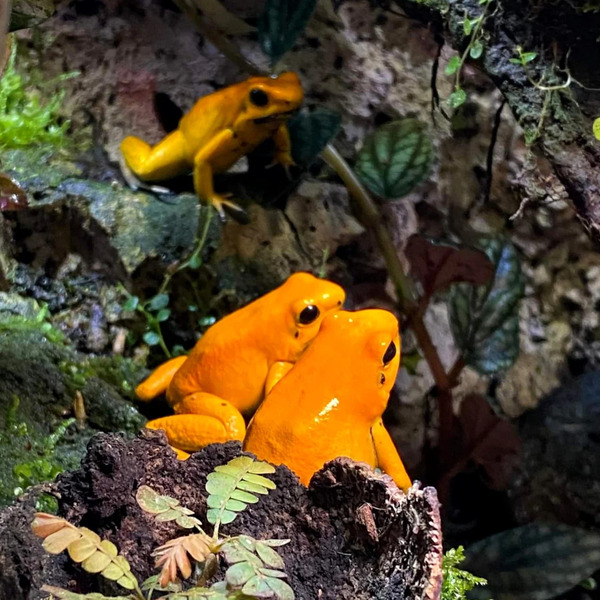
Great for beginners: Despite its dangerous reputation in the wild, the Phyllobates terribilis 'Orange' is known for being hardy and easy to care for in captivity, making it an ideal species for novice frog keepers.
Intense orange coloration: This frog’s vivid orange color makes it stand out among other dart frogs, making it a popular choice for those who want a visually striking pet.
Group-friendly: These frogs can be housed in groups, provided there is enough space in their enclosure.
Bold behavior: Unlike some other dart frogs, Phyllobates terribilis is bold and often seen out in the open, rather than hiding all the time.
Loud call: Males produce a loud, trilling call, especially when they reach sexual maturity at around 8-10 months.
Large for a dart frog: These frogs can grow to about 2 inches, making them one of the larger species in the dart frog family.
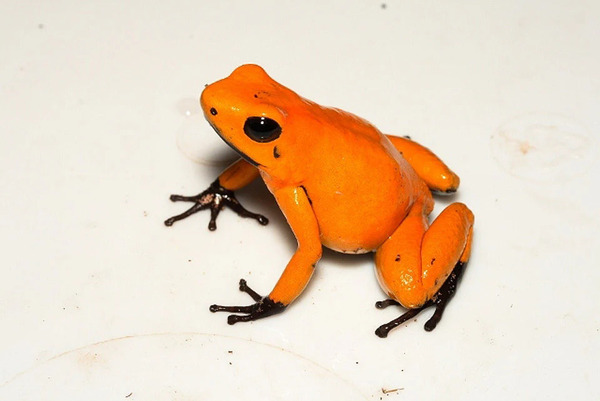
The Phyllobates terribilis gets its name from the historical use of its toxin by indigenous tribes in Colombia. These tribes used the powerful toxins secreted by the frog's skin to coat the tips of their blow darts for hunting. The alkaloid toxins, particularly batrachotoxin, are so potent that even a small amount is lethal. In fact, just 1 milligram of batrachotoxin from a single frog's skin is enough to kill 10 to 15 humans or two African Elephants-Are-Endangered.html">elephants. This remarkable toxicity has given the frog its ominous moniker, “The Terrible Dart Frog.”
However, the frogs only produce these deadly toxins when they consume specific prey in the wild, such as certain ants, beetles, and other small invertebrates. Frogs raised in captivity, where their diet consists of non-toxic prey like fruit flies, lose their toxicity and are completely safe to handle.
In the wild, Phyllobates terribilis 'Orange' is found along the Pacific coast of Colombia, primarily in the dense tropical rainforests. This region is characterized by high humidity and consistent rainfall, creating the perfect environment for these amphibians. Unfortunately, habitat loss and other environmental pressures have significantly reduced their natural population, making conservation efforts crucial. Interestingly, the captive population of Phyllobates terribilis is now believed to be much larger than the wild population.
A proper vivarium setup is essential for ensuring the health and longevity of these frogs in captivity. Here’s what you need to know:
Tank Size: A single Phyllobates terribilis 'Orange' can comfortably live in a 10-gallon tank, but for groups of 2-3 frogs, it’s best to provide a larger enclosure, such as a 29-gallon tank or a vivarium that’s at least 24x18x18 inches.
Temperature: These frogs prefer temperatures between 65°F and 80°F, with the ideal range being in the low to mid-70s. Temperatures above 80°F can be dangerous, as dart frogs are sensitive to heat.
Humidity: High humidity is critical. Ideally, the humidity should be kept between 70% and 100%, but the frogs can tolerate short periods of lower humidity (down to 50%) if they have access to water. Prolonged exposure to low humidity without water can quickly be fatal.
Substrate and Plants: To mimic their natural environment, use a substrate that retains moisture, such as a mix of coconut fiber, moss, and leaf litter. Including live plants, such as bromeliads and ferns, helps maintain humidity levels and provides hiding spots for the frogs.
Phyllobates terribilis 'Orange' is known to do well in groups, provided there is enough space. It's important to note, however, that the social dynamics may change as they mature. When they reach sexual maturity (between 18-24 months), females may start competing with each other and even eat each other’s eggs. For this reason, some breeders recommend housing adult frogs in pairs rather than groups to ensure successful breeding.
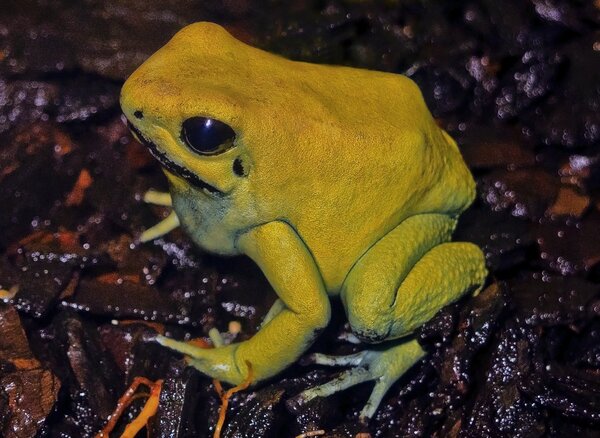
In the wild, Phyllobates terribilis derives its potent toxins from a diet of toxic insects like ants, beetles, and mites. In captivity, their diet is completely different, and they rely on a steady supply of live, non-toxic insects. Here are the primary foods for captive Phyllobates terribilis 'Orange':
Fruit Flies: Both Drosophila melanogaster and Drosophila hydei are commonly fed to dart frogs, with young frogs preferring the smaller melanogaster species and adult frogs readily consuming the larger hydei.
Crickets: Adult frogs can also be fed small crickets, up to half an inch in size.
Supplementation: All feeder insects should be dusted with a vitamin and mineral supplement to ensure the frogs receive all the necessary nutrients. This is especially important for calcium, which helps prevent metabolic bone disease.
Additionally, Phyllobates terribilis frogs will benefit from occasional feedings of springtails and isopods, which help break down waste in the vivarium while providing extra nutrition.
Phyllobates terribilis 'Orange' is relatively easy to breed in captivity, though breeding may not begin until the frogs are at least 2-3 years old. The breeding process typically starts when the female lays eggs on a smooth surface, such as a broad leaf or a petri dish, under a shelter like a coconut hut.
After being laid, the eggs take about 10-14 days to hatch into tadpoles, which then take 60-80 days to undergo metamorphosis into miniature versions of the adult frogs. It’s not uncommon for breeders to remove the eggs and raise the tadpoles in a separate container to increase their chances of survival.
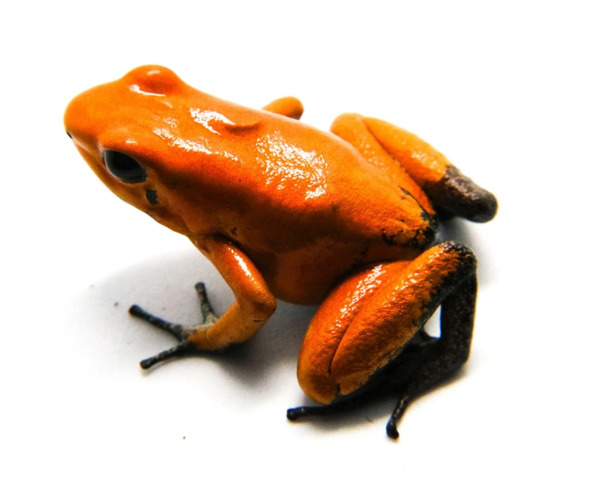
Sexing Phyllobates terribilis 'Orange' can be tricky. Males can often be identified by their loud, trilling call, which begins when they are about 8-10 months old. They may also develop black stretch marks on their throats from frequent calling. Females, on the other hand, tend to be larger and bulkier, but size alone is not always a reliable indicator of sex. In many cases, the only sure way to sex these frogs is to wait until they begin laying eggs.
As juveniles, Phyllobates terribilis 'Orange' are primarily black with a distinctive yellow or orange U-shaped pattern on their backs. As they mature, this coloration expands and covers most of the frog’s body, leaving only small black areas around the nose, mouth, and toes. Unlike some other dart frog species, Phyllobates terribilis 'Orange' shows very little variability in color or pattern among individuals.
With proper care, Phyllobates terribilis 'Orange' can live for more than 20 years in captivity, although a lifespan of around 10 years is more typical. Their longevity, combined with their striking appearance and ease of care, makes them a long-term commitment but a rewarding pet for experienced keepers.
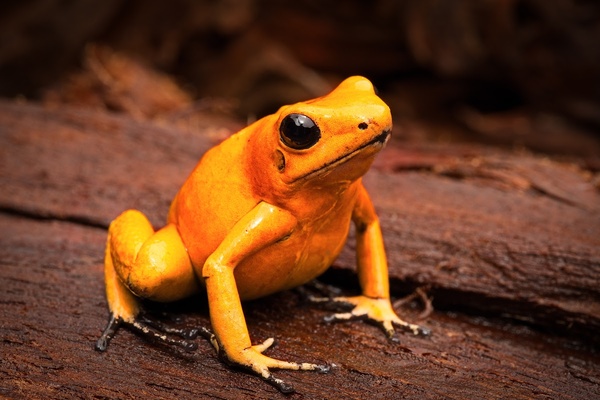
The presence of Phyllobates terribilis in the American pet trade is largely due to imports from Germany in the late 1990s. While wild-caught dart frogs are no longer exported from Colombia, the captive population has thrived, and captive-bred frogs are now widely available.
The Phyllobates terribilis 'Orange' is a remarkable species of dart frog, both for its deadly reputation in the wild and its stunning appearance in captivity. While wild specimens are toxic, captive-bred individuals are completely safe and non-toxic, making them a favorite among dart frog enthusiasts. Whether you’re looking for a bold and beautiful pet, or you’re interested in breeding, this species offers an intriguing and rewarding experience for frog keepers. With proper care, these frogs can live long, healthy lives, providing a fascinating glimpse into the world of tropical amphibians.
animal tags: Phyllobates-terribilis
We created this article in conjunction with AI technology, then made sure it was fact-checked and edited by a Animals Top editor.